Managing a case - contested
Updated 19 August 2024
1. Before you start
Before you can access financial remedy services using MyHMCTS, you and your organisation must have completed other steps.
1. Set up a HMCTS Payment by Account (PBA) (so that you can pay any relevant fees)
2. Registered your organisation with MyHMCTS
3. Set up your MyHMCTS user account
The MyHMCTS guidance has further information and instructions. If your organisation has an account already, contact the administrator to arrange for your account creation.
Once you have a MyHMCTS account, you can sign in using your email address and password.
If you need additional help with MyHMCTS email MyHMCTSsupport@justice.gov.uk. We aim to respond within 5 working days.
Also see the guidance for how to complete case administration tasks.
2. View form A, form C and form G
1. Once submitted and issued, your case will be referred to a judge for gatekeeping directions.
2. The case will be listed for a first appointment hearing in accordance with the judge’s instructions. We’ll email you once a copy of form C and form G are available to download.
3. You can then upload documents for the first appointment hearing.
4. You’ll find a sealed version of form A in the ‘Case documents’ tab, along with form C and form G. If the case is listed for a fast-track hearing, you will have just form A and form C.
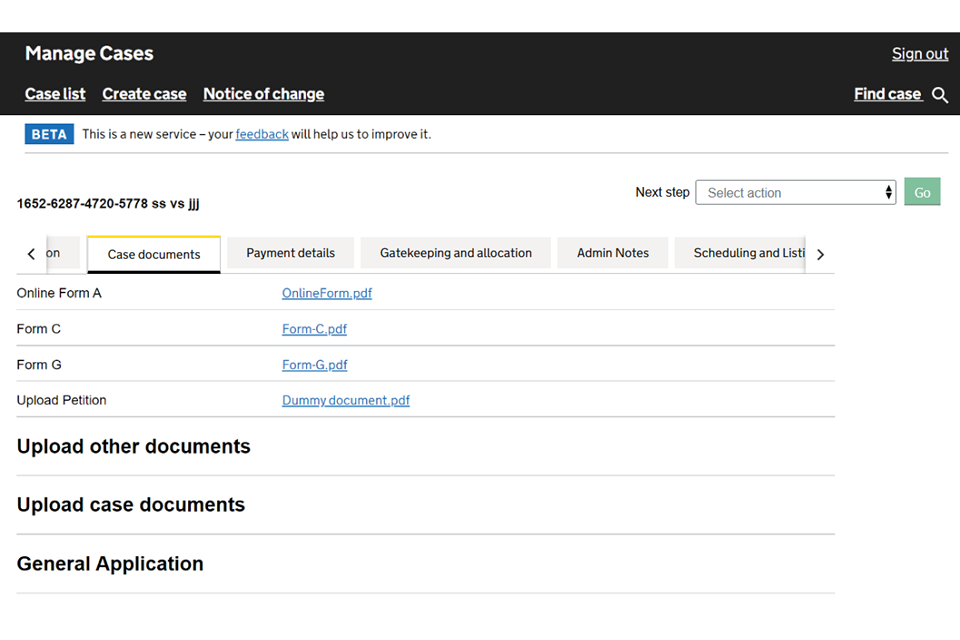
5. The form C will also give instructions on filing the FM5. You must file and serve the FM5 form as part of the non-court dispute resolution (NCDR) process. This must state your views on using NCDR to resolve matters raised in the proceedings. You must file and serve the form FM5 before the first directions appointment.
3. Upload evidence in support
You must upload case documents on MyHMCTS – do not submit them directly to the financial remedy centre. You can upload documents at any point during proceedings. These documents will automatically be added to your documents tab and will only be available to you and the court.
It is your responsibility to name your files clearly with the:
- name of the related person
- document type
- date the document was created or signed
For example, ‘JaneSmith-FormE-01-05-24’.
1. To upload a document, select ‘Upload Case Files’ from the next step dropdown. Then select ‘Go’.
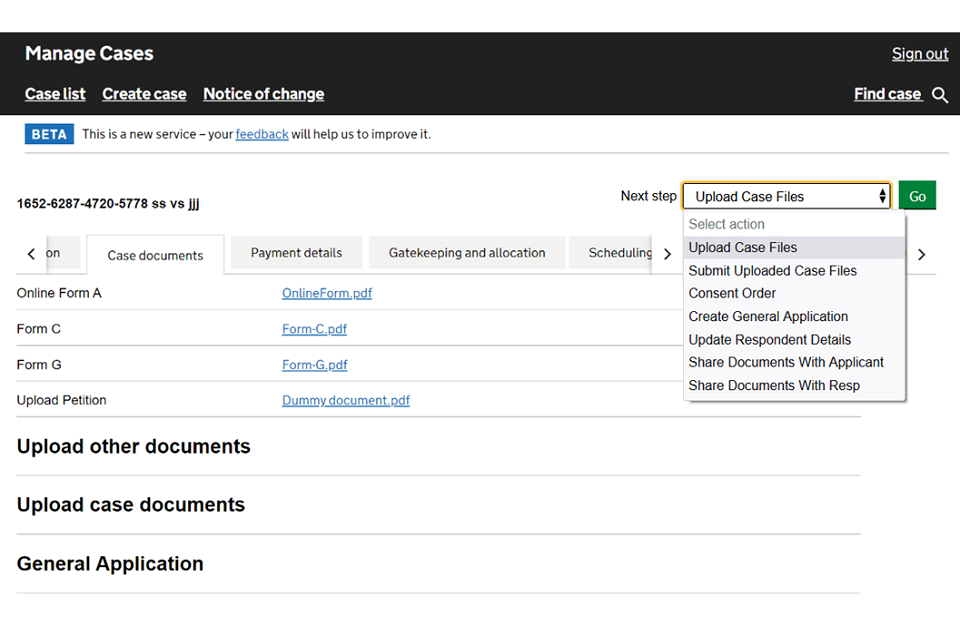
2. Select ‘Add new’ then ‘Choose file’ and browse for the document. Make sure the document name reflects the document being uploaded. For example, ‘JaneSmith-FormE-01-05-24’. This detail is useful when selecting which documents to share.
3. Select the document type from the dropdown and enter any other information about the document, such as a description and the date of the next hearing.
4. Select whether the document should be kept confidential or not. If you select that a document is confidential, it will be stored in the ‘Confidential documents’ tab, which only the court can access.
5. Select whether the document is for a financial dispute resolution (FDR) hearing. If yes, the documents will appear in the FDR tab.
6. If you need to add another document, select ‘Add New’ and repeat steps 2 to 5.
7. When you have entered all information, select ‘Continue’.
8. Check the answers – if you need to make any changes, select ‘Change’ against what you need to change. Once all answers are correct, select ‘Submit’.
9. MyHMCTS will know which party you are acting on behalf of. When you select ‘Submit’ the documents will be added to your documents tab.
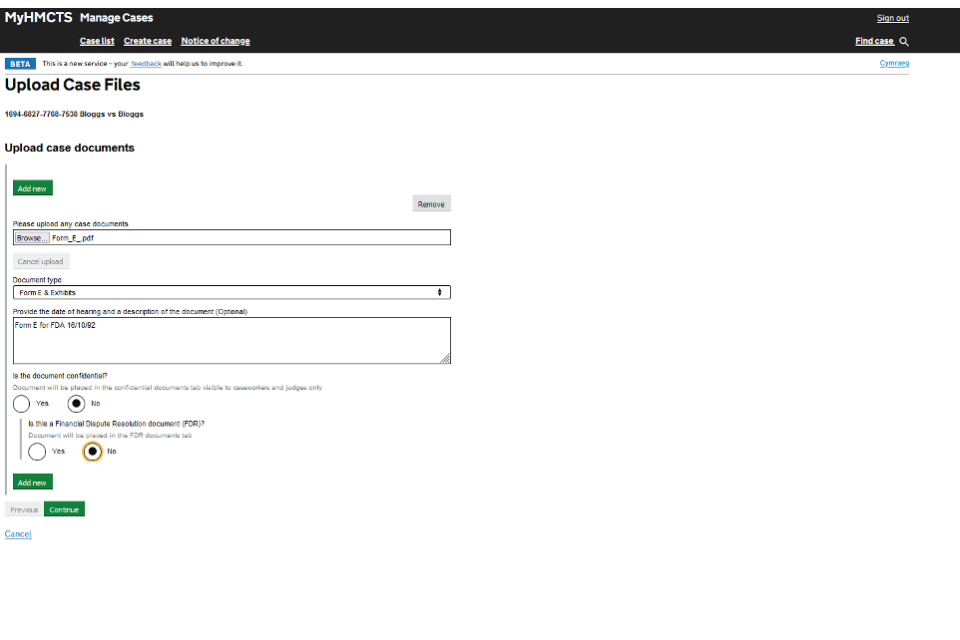
You must share the documents directly with the other parties. They cannot view uploaded documents automatically.
10. To share your documents with the other parties, select ‘Share Documents’ from the next steps dropdown.

11. Select from the list which documents to share by selecting the tick box next to each document.
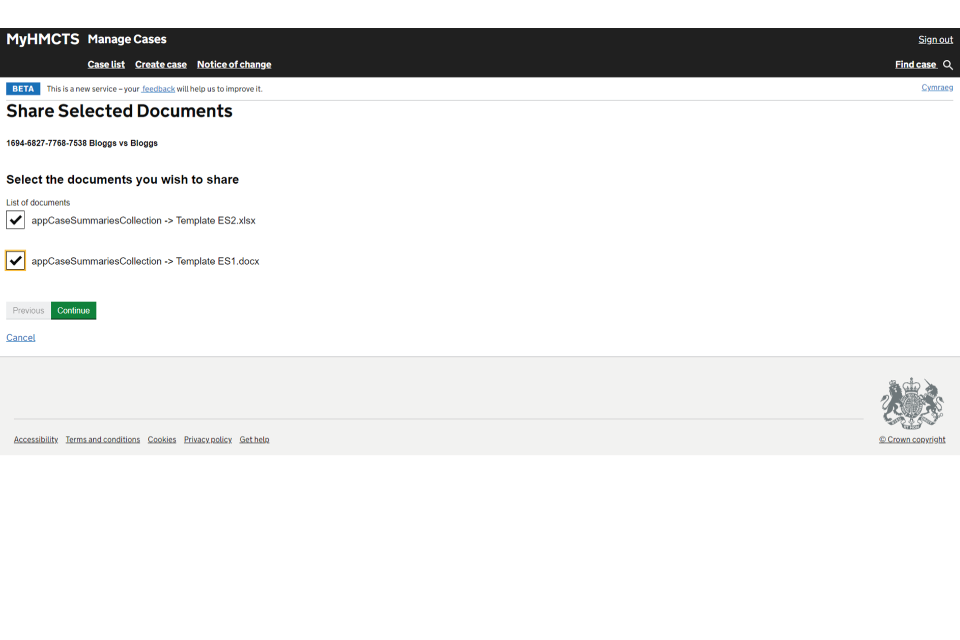
12. Select which parties to share the documents with.
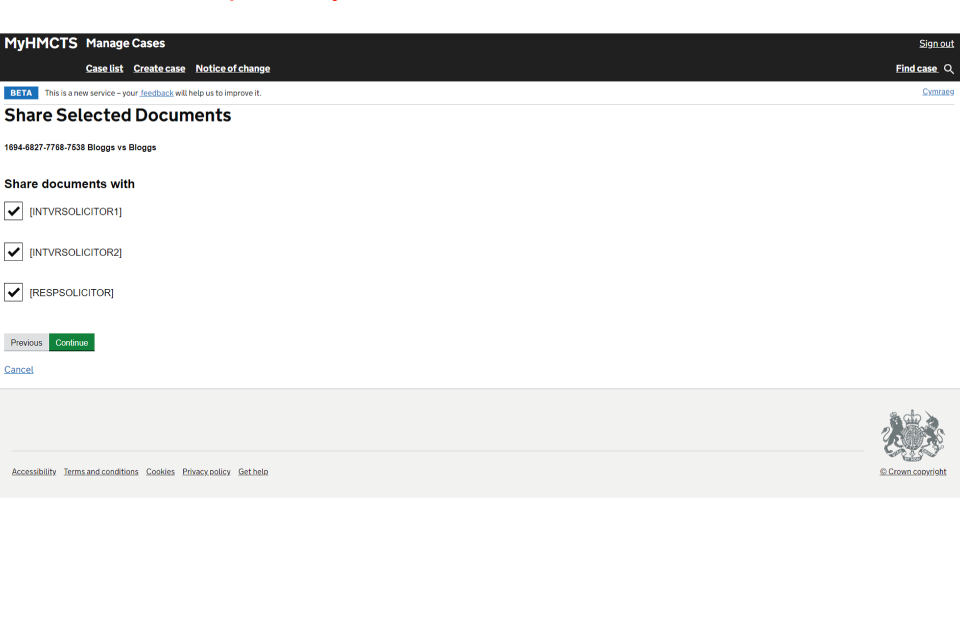
13. Once you have shared the documents, they will appear in the ‘Shared documents’ tab.
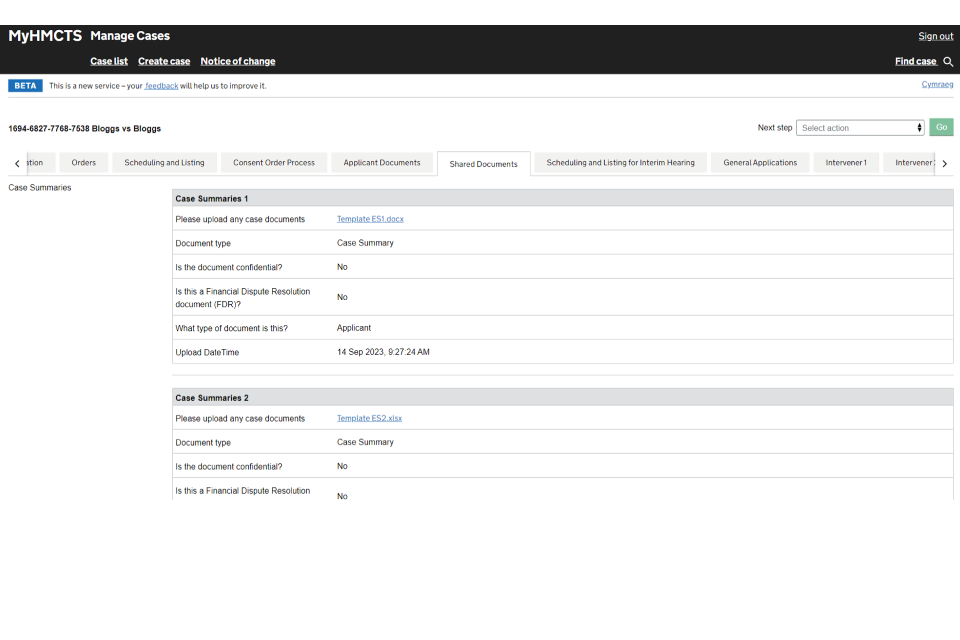
4. Upload the hearing bundle
1. To upload the hearing bundle, select ‘Manage Hearing Bundles’ from the next step dropdown. Then select ‘Go’.

2. Select ‘Add new’ and enter the date to which the bundle relates.
3. Choose whether it is a financial dispute resolution hearing.
4. Select ‘Choose file’ and browse to find the bundle document.
5. Add a description, if relevant. Then select ‘Continue’.
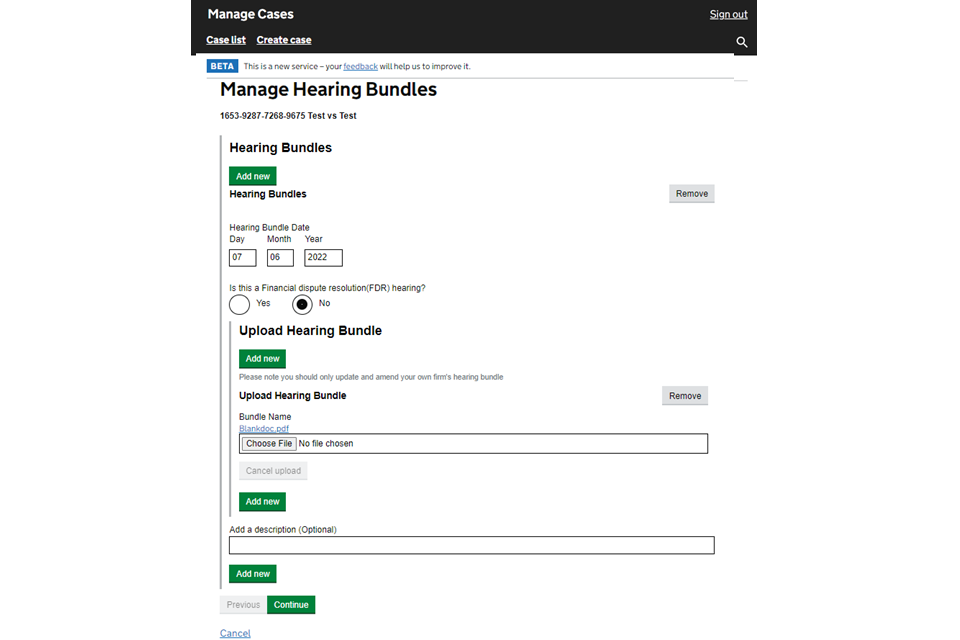
6. To update the bundle, follow the same steps and upload the updated bundle or enter a new hearing date if incorrect.
7. To remove a bundle, select and open the right one from those filed. Then select ‘Remove’ against the bundle you want to remove.
8. To confirm you are sure you want to remove the bundle, select ‘Remove’ on the pop-up screen.

5. Upload a draft order
Follow the guidance in this section if you’re applying for an:
- agreed order before a hearing as part of the accelerated procedure. This is where you agree with the respondent on directions before the first appointment, and send the agreed order to be approved by the judge without a hearing
- agreed order following a hearing – once submitted, you should only email the court if the judge has asked you to
For contested orders to adjourn or vacate hearings, or any other interlocutory requests, you must use the general application function.
Once you have an agreed order, you must upload this for the judge to approve.
You must use the following information to name the order document - parties’ name, hearing type, and date of hearing - in the format ‘JonesFDA11Mar2023’. The judge’s name and hearing date must be included on the order before uploading.
1. Select ‘Upload Draft Order’ from the next steps drop down. Then select ‘Go’.
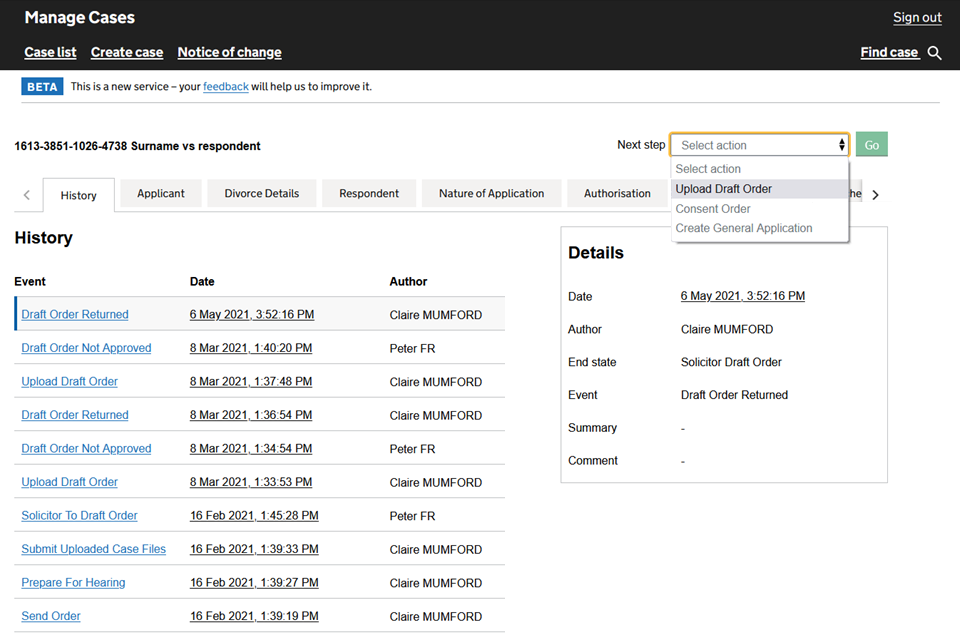
2. In the ‘Upload Draft Order’ section of the next screen, select ‘Add new’ and browse for the file. The order must be in Word format.
3. Select the purpose of the document from the dropdown menu. Then select ‘Continue’.
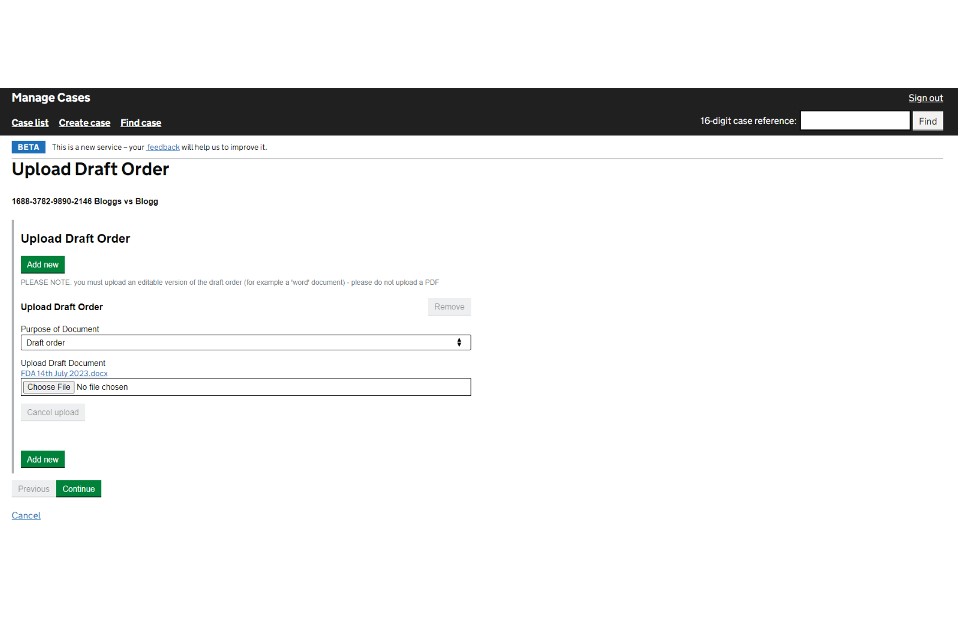
4. Approved orders will appear in the ‘Orders’ tab. They will appear in ‘Applicant Documents’ for applicants, and ‘Respondent Documents’ for respondents.
5. General orders will appear in either ‘Applicant Documents’ or ‘Respondent Documents’, depending on who the court send the order to. This is so confidential orders can be drawn without the other party having access.
6. Add a general application to the case
Follow the guidance in this section if you are adding a non-confidential general application.
If you are adding a confidential general application, you should use the ‘Upload Case files’ function, making sure to select ‘Confidential’. You should then email the court to tell them that the application has been submitted as a case file due to confidentiality.
You should also follow the guidance in this section if you’re applying to:
- vacate a hearing by consent
- vary a maintenance order
- capitalise maintenance
- set aside a financial remedies order
For agreed orders following a hearing, you must use the upload a draft order function.
You can make a general application at any stage of the case, for example if you are seeking to have a hearing adjourned. You must upload the application and any draft order in PDF format.
1. Select ‘Create General Application’ from the next steps dropdown list. Then select ‘Go’.

If previous applications on the case are listed, make sure to not overwrite them.
2. Select ‘Add new’ to create a new general application.
3. Select ‘Applicant’ as the person applying.
4. Select ‘Yes’ if you need a hearing. Enter the amount of time you estimate you’ll need for a hearing and any special measures needed from the court.
5. Select ‘Choose file’ to upload the general application.
6. Select ‘Choose file’ to upload any supporting documents.
7. Select ‘Continue’.

8. If appropriate, you can add an event summary and description. When ready, select ‘Submit’.

When you submit, the court is notified of the application and they will contact you to arrange payment, if required.
9. When the judge has considered the application, you will be able to view their comments in the ‘Case documents’ tab.
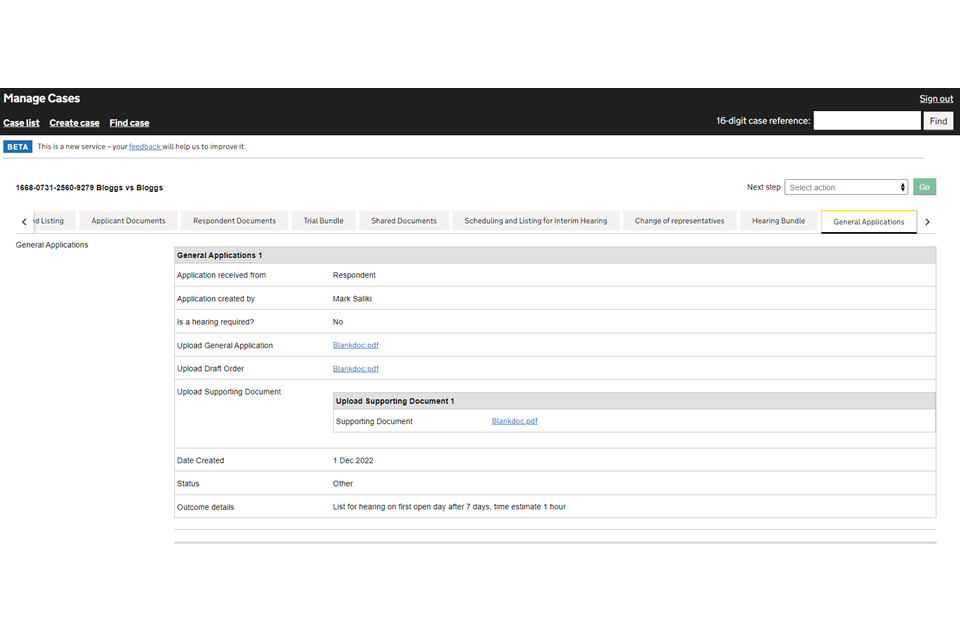
You will also receive a copy of the application, draft order and the court’s directions in the post.
You can ask the court to remove your application if:
- it has been filed by mistake
- you wish to withdraw your application and no action has been taken on the case
7. Enforcement application
You must use the general application function to make an enforcement application. You must upload the application, any draft orders and supporting documents in PDF format.
To add a confidential application, you must use the upload case files function, making sure to select ‘Confidential’.
You must email the court to tell them that the application has been submitted as a case file because of confidentiality.
8. Add a final consent order to settle the proceedings
Apply for a consent order using the ‘Consent Order’ function if your client and the respondent agree in full on the proceedings and wish to finalise them.
Do not use the ‘Consent Order’ function if the agreement is recorded at a hearing, or shortly after a hearing, before a particular judge. In these circumstances follow the judge’s instructions or see the guidance on how to upload a draft order.
This is currently only available to applicant solicitors and not respondent solicitors. Respondent solicitors must send a D81 form, supporting documents and pension documents to the financial remedy court.
If you are making a general application by consent, you must use the general application function.
1. Select ‘Consent Order’ from the next steps dropdown menu.
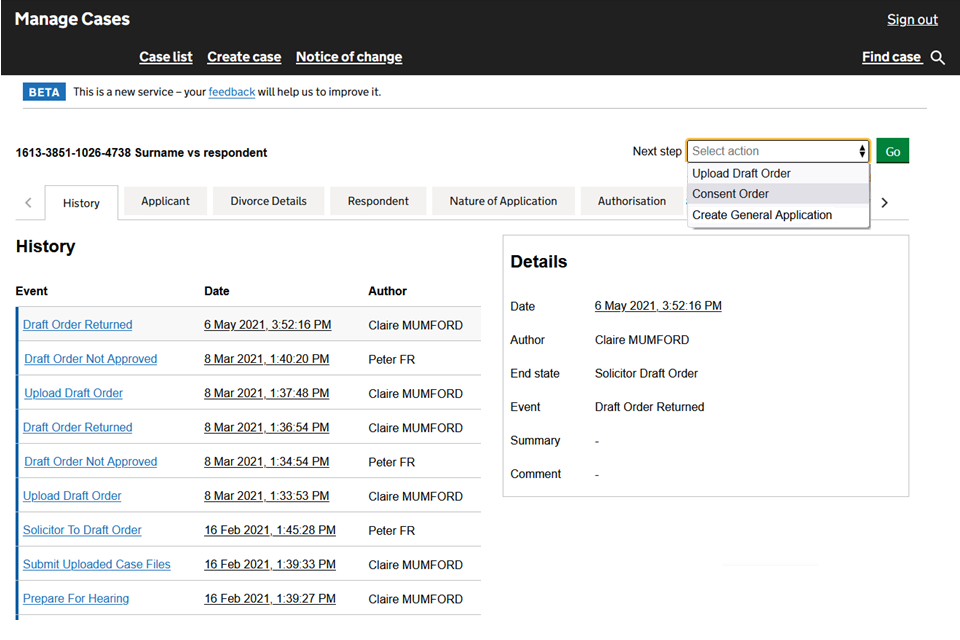
2. Select the nature of the application. Then select ‘Continue’.
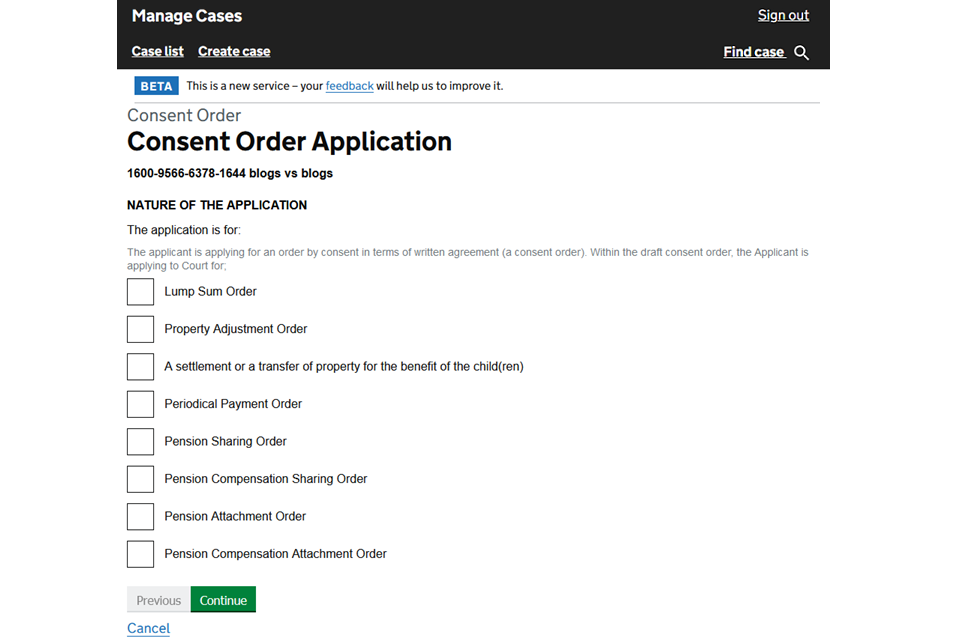
3. Browse for and upload a copy of the draft consent order in PDF format. Then select ‘Continue’.
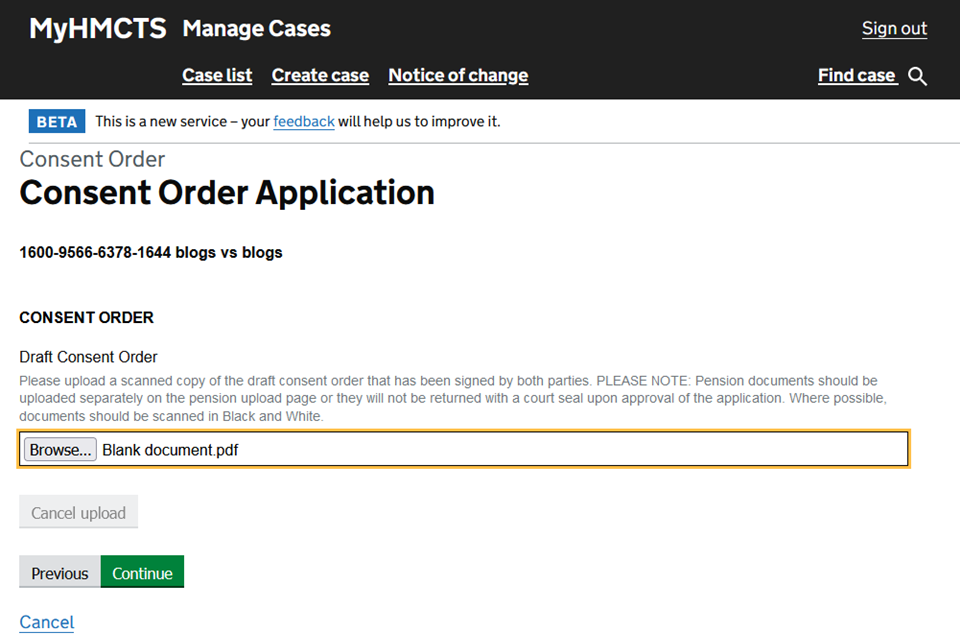
4. Browse for and upload a copy of the D81 form – this is to provide information about the parties’ financial situation to support your application for a consent order.
5. Select whether the copy you are uploading is a joint D81 with the other party. Then select ‘Continue’. If a D81 is not needed because you have uploaded form E documents, upload a blank document to continue.
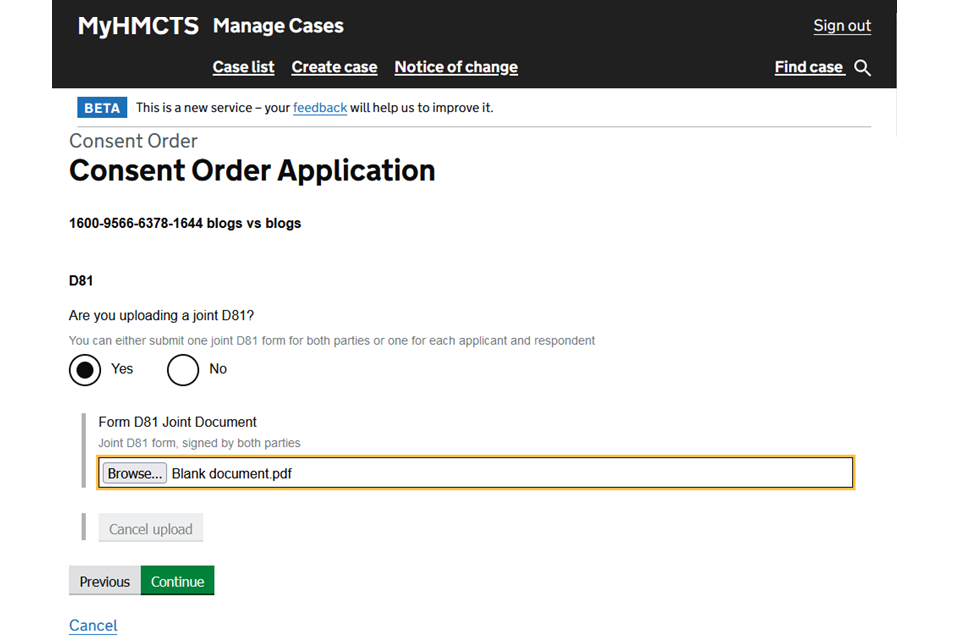
6. If you are applying for a pension sharing or attachment order, select ‘Add new’ and upload a PDF copy of the documents. Then select ‘Continue’.
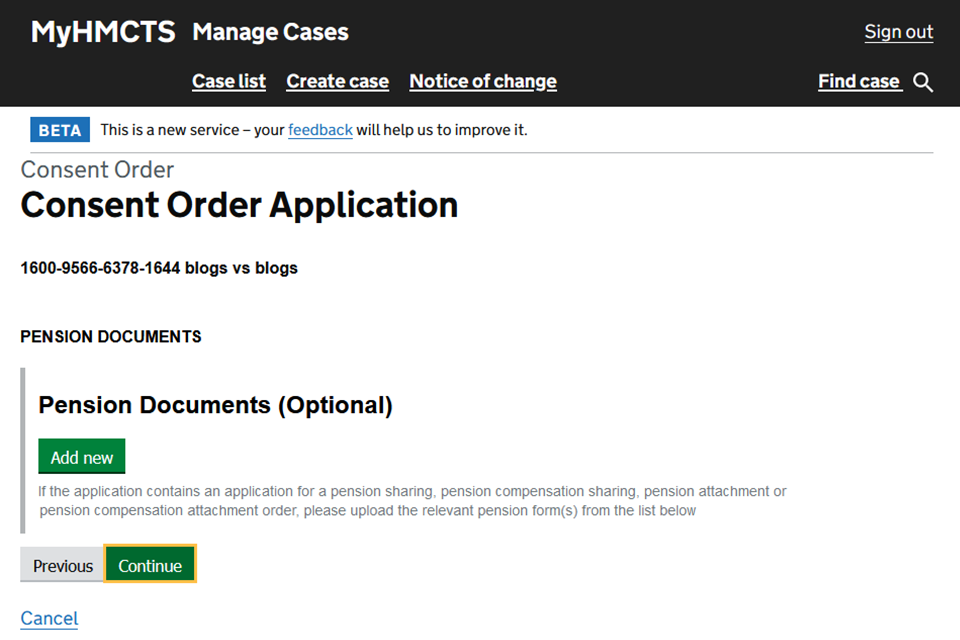
7. Check your answers. If you need to amend anything, select ‘Change’ next to the appropriate answer. When everything is correct, select ‘Submit’.
When you have submitted the consent order, the court will contact you to arrange payment of any fees. The case will be referred to a judge for directions.
When the judge has made a decision, the order will be available in the ‘Consent Order Process’ tab. The court will email you when the order is available.

9. Submit a notice of change
You can submit a notice of change (or acting) on MyHMCTS for cases issued online, or when a case is issued on paper but then uploaded to MyHMCTS by the case worker.
Use the 16-digit financial remedy case number, not the divorce case number. Your notice of change will fail if you use the divorce case number.
Once you have submitted your notice of change, you will be able to access the case immediately.
Use a notice of change through MyHMCTS to:
- change the solicitor or firm on the case, or
- add a solicitor where the applicant was previously unrepresented
If you wish to stop representing a client, you need to make a request to the local financial remedy centre.
If a solicitor being added is not registered on MyHMCTS, they will not be able to access the case.
See the case administration guide for how to submit a notice of change or acting.
10. Add or remove a barrister
Add a barrister to a case
When you instruct a barrister, you can give them access to the case. They must be registered with MyHMCTS before you can add them.
If the client instructs the barrister directly, the barrister must notify their local financial remedy centre, who can add them to the case.
1. Open the case and select ‘Manage Barrister’ from the next step dropdown menu. Then select ‘Go’.
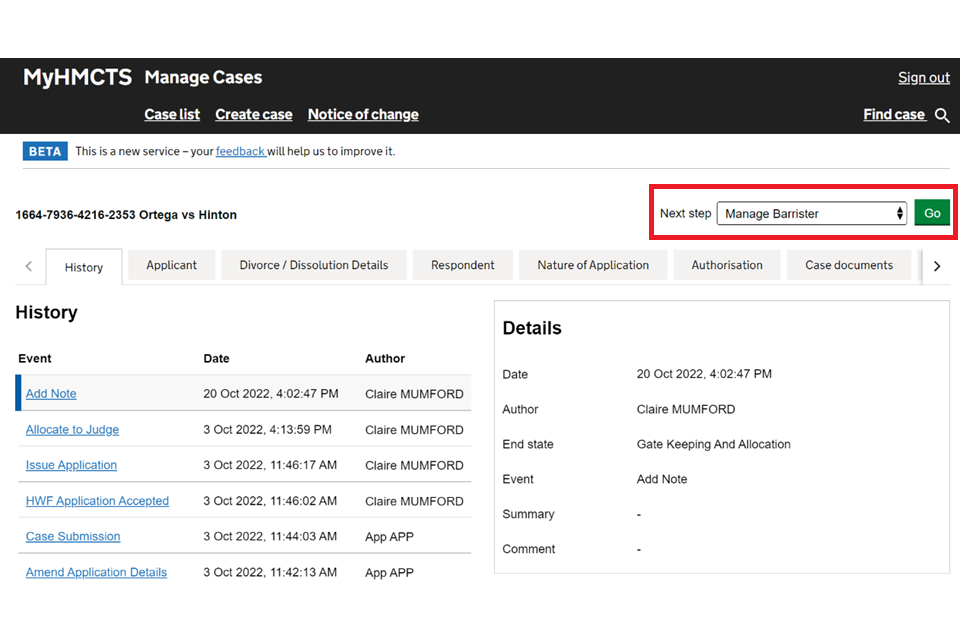
2. Select ‘Add new’ then enter the barrister’s details. Use the ‘Search for an organisation’ box to find and select the barrister’s firm. The details you enter must match the barrister’s details as they are registered on MyHMCTS.
3. If you need to add more than one barrister, select ‘Add new’ again and repeat step 2. You can also do this later by selecting ‘Manage Barrister’ and following the same steps.
4. Once you have added all the barrister details, select ‘Continue’.

5. Check your answers. If you need to amend anything, select ‘Change’ next to the appropriate answer. When everything is correct, select ‘Submit’.

6. You will return to the History tab to see the event has updated to ‘Manage Barrister’.

The barrister and the other party or their solicitor will receive an email to say they have been added to the case. The case will also appear in the barrister’s case list.
They will have full access to the case to upload and manage case documents and orders.
Remove a barrister from a case
You can remove a barrister from a case when they are no longer instructed.
1. To remove a barrister select ‘Manage Barrister’ from the next step dropdown menu. Then select ‘Go’.
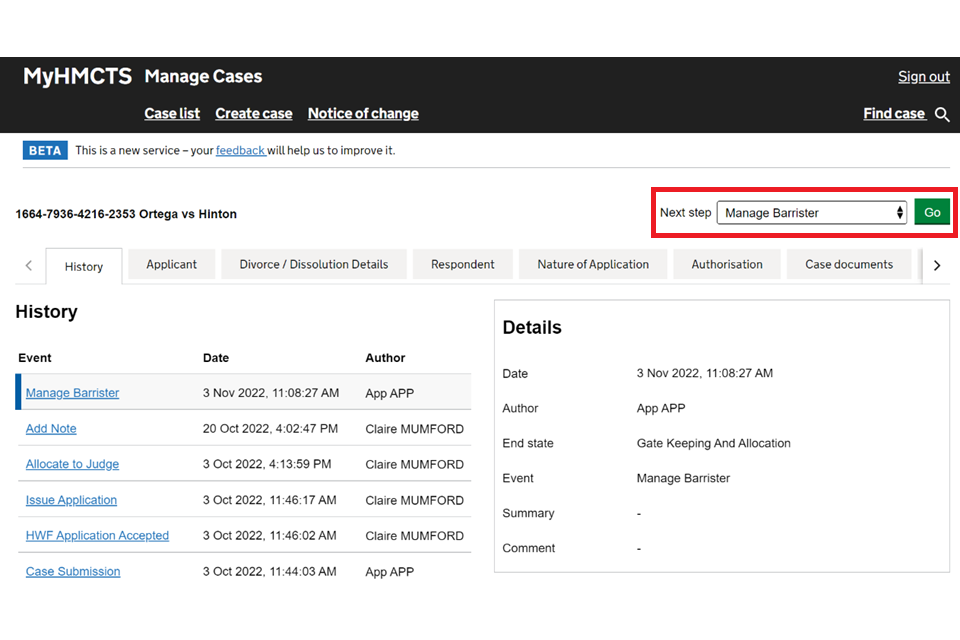
2. Select ‘Remove’ for the barrister that you need to remove from the case.
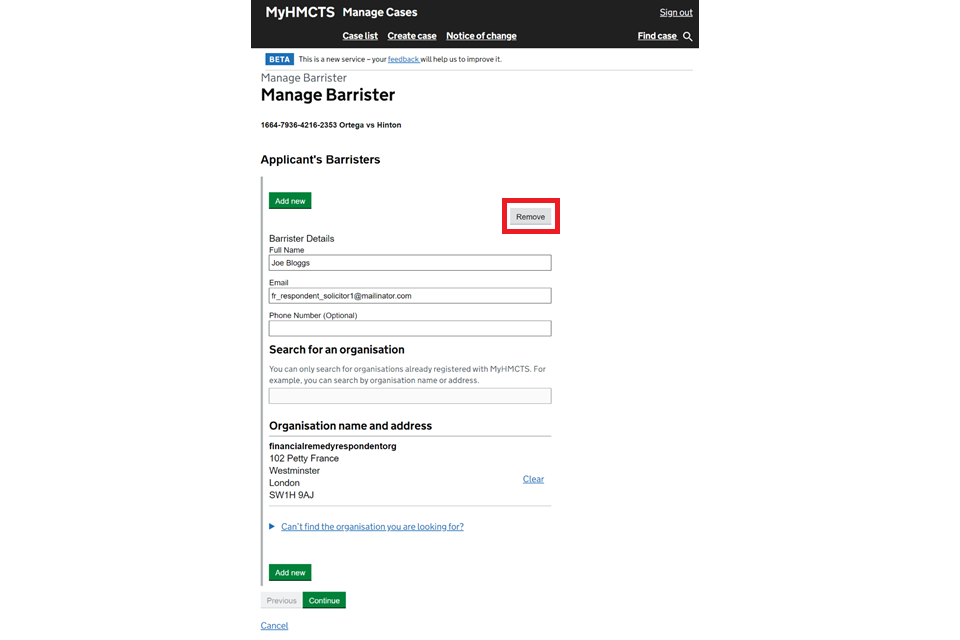
3. Select ‘Remove’ again on the confirmation box. Then select ‘Submit’.

4. The barrister’s details will no longer appear on the ‘Check your answers’ page. Select ‘Submit’.
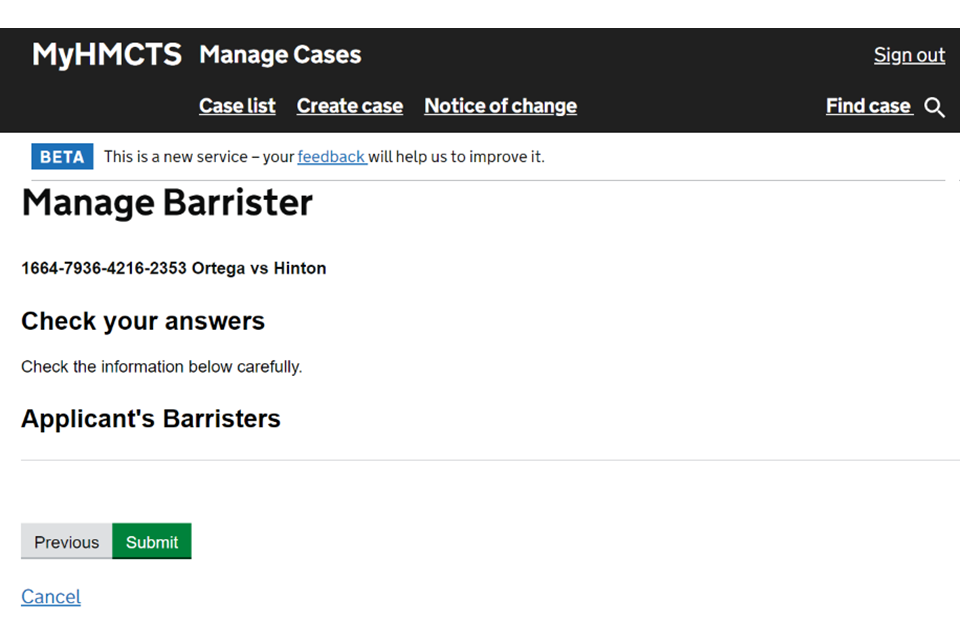
The barrister will receive an email to say they have been removed from the case. The case will no longer appear in their case list.
11. Get help with MyHMCTS
Managing cases and case access in MyHMCTS
If you need help with your case, contact the financial remedy centre (FRC) managing your application. Find the contact information at HMCTS Financial Remedy Centres.
If you see an error message in MyHMCTS that you cannot resolve, or if you have feedback on how we can improve, contact the HMCTS Financial Remedy Service Team at HMCTSFinancialRemedy@justice.gov.uk.
Find guidance for case administration tasks in MyHMCTS
Accessing your MyHMCTS account
If you are having trouble accessing MyHMCTS, make sure you are using the correct link. To manage a case, you must use https://manage-case.platform.hmcts.net.
You should also make sure you:
- check your internet browser is up to date – we recommend you use Google Chrome or Microsoft Edge (you cannot use Internet Explorer or Apple Safari)
- clear your cookies and your cache
- check your firewall and security settings
We recommend that you bookmark or favourite MyHMCTS in your internet browser. You should only create the bookmark or favourite once you have signed in and are on the homepage. Do not create it from the sign in or verification pages, or while you have a case or organisation open.
If you are still having trouble accessing MyHMCTS, try using a different device to sign in.
If you have an IT support team, they will be able to help with any device, browser and security issues.
If you have an issue with your MyHMCTS account, you should contact an account administrator in your organisation.
If you need additional support with your MyHMCTS account, email MyHMCTSsupport@justice.gov.uk. We aim to respond within 5 working days.
